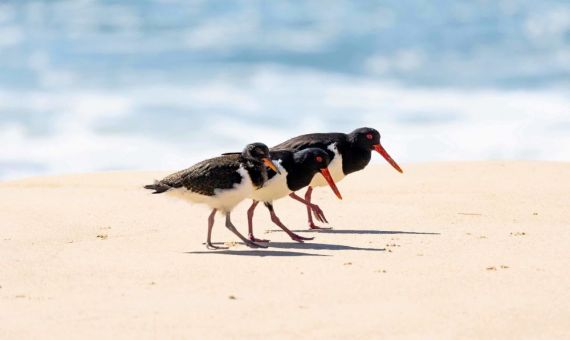Minimising wildlife disturbance while fishing
As with many other outdoor recreational activities, being out and about in nature can also mean being around native wildlife including shorebirds and marine mammals. This is one of the great things about having such a wonderful and diverse marine environment. However, we all need to remember that our presence and actions can have an impact on their health and wellbeing.
Shorebirds
In NSW, threatened beach-nesting birds, such as the pied oystercatcher, hooded plover and beach stone-curlew return to preferred nesting sites to breed over spring and summer. However, these birds are in danger and need your help. Every year less and less birds are successfully fledging, which has led to a steady decline in beach-nesting bird numbers. These beautiful birds are at risk and collectively our behaviours on the beach can impact them during this sensitive period. Check out a short and informative video.
There are a few simple steps you can take to help keep beach-nesting birds safe:
- Look out for bird nesting signs or roped-off nesting areas on the beach and follow the advice, especially when pumping for bait such as nippers or squirt worms.
- Walk your dogs on dog-friendly beaches only and always keep them on a leash, unless you’re on a designated off-leash beach.
- Drive only on designated beaches and keep below the high-tide mark.
- When you’re near a nesting area, stick to the wet sand and give the birds plenty of space.

Marine Mammals
Whales, dolphins, dugongs, seals and sea lions are protected in NSW. Keep these animals and your vessel safe – follow these rules when watching or approaching them while out fishing.
Keep your distance - marine mammals may unexpectedly lash out if feeling threatened and there is risk of serious injury. Approaching too closely will cause animals to change their natural behaviour resulting in impacts on their health, wellbeing and survival. For your safety and the welfare of marine mammals, you should keep your distance. Intentionally harming, touching, harassing, chasing, trying to restrict their path, or getting too close, is illegal.
Check out the approach distances below. This is the closest you can go to a whale, dolphin, dugong or seal to watch it safely and without disturbing them. Scientists, including veterinarians, helped to develop the Biodiversity Conservation Regulation 2017, which outlines the approach distances for New South Wales. These are based on The Australian National Guidelines for Whale and Dolphin Watching 2017 and also includes seals. For more information see: https://www.environment.nsw.gov.au/topics/animals-and-plants/native-animals/approaching-marine-mammals-in-nsw
Some populations of marine mammals (such as seals in local areas) have responded to the presence of fishers by modifying their behaviour to take advantage of the foraging opportunities provided. If seals or other mammals are present, do what you can to limit your interaction. If they persist in the area, consider moving elsewhere to avoid them. Don’t berley, discard bait or cleaned fish scraps into the water when they are present and do not ever feed the animals as they may form an association with the area and food.